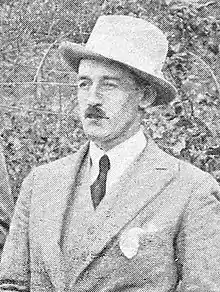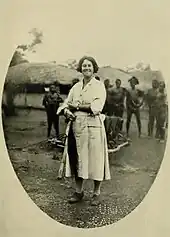Thomas Alexander Barns | |
|---|---|
 Barns in 1920 | |
| Born | 4 June 1881 Bletchingley, Surrey, England |
| Died | 4 March 1930 (aged 48) Chicago, Illinois, United States |
| Other names | T. A. Barns, T. Alexander Barns, Alexander Barns |
| Education | St John's College, Oxford |
| Occupation | naturalist |
| Known for | expeditions in Africa |
| Spouse | Margery Cory |
Thomas Alexander Barns FZS FES (4 June 1881 – 4 March 1930), known in his private life as Alexander Barns, was an English businessman, explorer, big game hunter, author, artist, naturalist and lecturer connected with the opening up of Central Africa by Europeans in the early 20th century.
The amateur entomologist James John Joicey commissioned Barns to collect specimens of lepidoptera in Africa on his behalf.
Early life and background
The second son of the Rev. William Amos Barns, by his marriage to Eva Cecilia Buckworth, Barns was born at Bletchingley, Surrey, in 1881 and educated at Cranleigh School.[1] His father was a Church of England clergyman and a graduate of St John's College, Oxford.[2] His mother, Eva Cecilia Buckworth, was the daughter of the Rev. Thomas Everard Buckworth (born 1822), Rector of Norbury, Staffordshire, whose mother Helena Hare Clarke was one of the sisters of General Sir John Clarke (1787–1854), a veteran of the Peninsular Wars. In 1868, at the age of thirteen, Eva Cecilia had been awarded the Royal Humane Society's Silver Medal for saving her ten-year-old sister Blanche Rosa from drowning in a pool of the River Erme at Ivy Bridge, Devon. She then needed to be saved herself by her governess.[3][4]
Career
In 1898, at the age of seventeen, Barns went to Africa as an assistant manager to the Nyasaland Coffee Company. From 1900 to 1903 he was agent for the Tanganyika Concessions in Northern Rhodesia, where he also worked in ranching and organised expeditions to German and Portuguese East Africa, shot elephants, traded ivory, and collected zoological specimens for museums, such as a large African elephant for the South Kensington Museum.[1]
Between 1919 and 1922 Barns led three Trans-African Research Expeditions through the Belgian Congo and the Tanganyika Territory. He became the first Englishman to describe the Ngorongoro Crater, a volcanic caldera in the Crater Highlands of what is now Tanzania, at that time the largest known crater in the world.[1]
In his The Wonderland of the Eastern Congo (1922), Barns was an early observer of mountain gorillas and reported that he had observed them living in large troops and that all such troops included at least two adult females with young of different ages.[5]
Some of Barns's expeditions to Africa were sponsored by James John Joicey, an amateur entomologist.[6] One of these trips lasted a year, when travelling with his wife Barns collected many specimens of Lepidoptera for Joicey's Hill Museum at Witley.[7][8] Barns's book Across the Great Craterland to the Congo (1924) followed an expedition to the Belgian Congo driven by the search for a rare giant Papilio butterfly, which Barns called "the Antizox".[9] He explained the name as "a play on the two names antimachus and zalmoxis".[10] On a previous expedition to the Congo for Joicey Barns had observed an example floating on the water just out of his reach.[11][12] Barns's report of the butterfly was so extraordinary that Joicey sent him back to the Congo in search of it, but no specimen was captured.[9]
Barns was a member of the African Society, the Shikar Club, and the National Geographic Society of Washington, D.C., and a correspondent for The African World, as well as publishing several books about Africa.[1] In 1921 he was elected a Fellow of the Entomological Society of London and was already a Fellow of the Zoological Society. He was then living in Bayswater, London.[13]

He married Margery, the daughter of Frederick Cory, and they had one son and one daughter.[1] His wife was an active participant in his expeditions to Africa to collect butterflies.[14] According to Sir Alan Lascelles, private secretary to Edward VIII when he was the Prince of Wales, Margery Barns was seduced by the future King of England during the Prince's tour of Africa in 1928.[15]
He died in Chicago in 1930, struck by a taxi-cab driver. An obituary in The Entomologist called him "A notable and inspiring figure among the naturalists, geographers and sportsmen of Africa".[9]
Publications
- The Wonderland of the Eastern Congo: the region of snow-crowned volcanoes, the pygmies, the giant gorilla, and the okapi, introduced by H. H. Johnston (1922)[1]
- Tales of the Ivory Trade (London: Mills & Boon, 1923)[1]
- Across the Great Craterland to the Congo (1924)[1]
- An African Eldorado, the Belgian Congo, introduced by Louis Franck (1926)[1]
- Angolan Sketches[1]
Notes
- 1 2 3 4 5 6 7 8 9 10 'BARNS, Thomas Alexander', in Who Was Who 1929–1940 (London: A. & C. Black, 1967 reprint, ISBN 0-7136-0171-X )
- ↑ The Ecclesiastical gazette, or, Monthly register of the affairs of the Church of England (1877), pp. 97–98
- ↑ DNW Lot 548, 13 Dec 07 at dnw.co.uk, accessed 4 January 2012
- ↑ Royal Humane Society Case No 18,108
- ↑ C. K. Ogden, Psyche: An Annual General and Linguistic Psychology 1920–1952 (1995), p. 51: "Mr. T. A. Barns has also found the gorillas in the Eastern Congo living in large troops consisting of 'quite a number of gorillas', each troop including at least two females with several young of varying ages (T. A. Barns, The Wonderland of the Eastern Congo)"
- ↑ Talbot, G. (1932). "Obituary. Thomas Alexander Barns". The Bulletin of the Hill Museum: A Magazine of Lepidoptera. iv: 145–153.
- ↑ Sir Norman Lockyer, ed., Nature, vol. 106 (Nature Publishing Group, 1921), p. 56: "The museum has lately also received large collections of Lepidoptera from Central Africa, obtained by Mr. and Mrs. T. A. Barns, who have recently returned from a twelve months' trip undertaken on behalf of Mr. Joicey."
- ↑ G. Talbot, 'New Lepidoptera collected by Mr T. A. Barns in East Central Africa' in Bernard d'Abrera, Butterflies of the Afrotropical region: based on Synonymic catalogue of the butterflies of the Ethiopian region by R. H. Carcasson, vol. 2 of Butterflies of the World
- 1 2 3 'Obituary: Thomas Alexander Barns' in The Entomologist, vols. 63–64 (Royal Entomological Society of London, 1930), p. 119: "By the tragic and untimely death of TA Barns at the age of 49 there has passed from us a notable and inspiring figure among the naturalists, geographers and sportsmen of Africa. After risking his life many times in the African jungle he was run over by a taxi-cab in Chicago on March 4th." ; "a butterfly... which Barns dubbed the "Antizox", but of which no specimen has so far become available for study. This insect appeared to be so remarkable that Mr. Joicey again sent Barns to the Congo a few months after his return from the first trip..."
- ↑ T. A. Barns, Across the Great Craterland to the Congo (1924), p. 90: "Before leaving, my discovery of a new giant Papilio (Mr. Talbot, Mr. Joicey's curator, and I gave it the name of " Antizox " [it sounds like some new patent medicine!] for brevity – a play on the two names antimachus and zalmoxis, to both of which species we thought the insect might be related)..."
- ↑ Book review digest, vol. 20 (H. W. Wilson Company, 1924), p. 34
- ↑ Thomas Alexander Barns, Across the great craterland to the Congo: a sequel to "The wonderland of the eastern Congo" (1924), Chapter V, 'In Quest of the "Antizox"'
- ↑ The Entomologist's record and journal of variation, 1921, p. 118: "Entomological Society of London: 3rd November 1920. — Election of Fellows. — Messrs. Thomas Alexander Barns, F.Z.S., 32, Windsor Court, Bayswater, London, W."
- ↑ Transactions of the Royal Entomological Society of London 1923 (Royal Entomological Society of London, 1923), p. xxi: "E. bettiana was taken by Mrs. T. A. Barns on the Marungu Plateau, S.W. Tanganyika, at 7000 ft., in Feb. 1922. A description of this species will appear shortly in the Entomologist.
- ↑ Diary entry of 5 March 1943, "King's Counsellor - Abdication and War - The Diaries of Sir Alan 'Tommy' Lascelles", edited by Duff Hart-Davis, updated edition published 2006